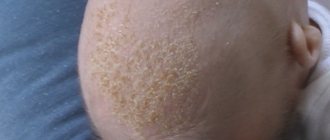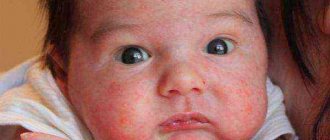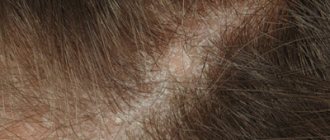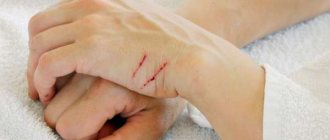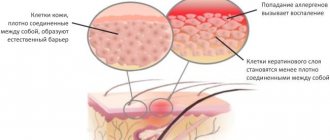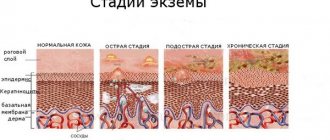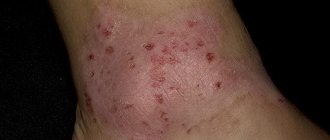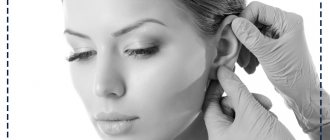When parents see rawness and redness on the baby’s delicate skin, they should be wary. Indeed, the appearance of such signs may indicate health problems. Therefore, you cannot do without consulting a doctor. One of the problems that parents have to deal with is contact dermatitis in infants. Let's figure out how the disease manifests itself and how it can be avoided.
The disease, called “contact dermatitis,” is a consequence of direct interaction with an irritant substance. This disease can develop not only in infants, but also in adults. But since in infants the protective functions of the skin are much less pronounced, children are more likely to suffer from this disease.
Irritants and allergens
Contact dermatitis in a child has 2 main forms - simple and allergic. Simple pathology develops without the participation of allergens. Most often, inflammatory processes occur due to contact with obligate irritants. These are objects and substances, contact with which causes a rash in all people, regardless of their age. Obligate irritants such as paints and varnishes, acids, alkalis and oils are rarely the main cause of pathology in infants under one year of age. After all, caring parents try to remove everything unnecessary and dangerous to the most remote and inaccessible corners of the home for their “child.” But a factor such as friction is the most common cause of dermatitis. Poor quality clothing, the presence of rough seams on the inside, carpets and rugs - all this can harm the health of the child. The influence of physical factors, which include high or low air temperature, solar energy, etc., cannot be excluded.
Allergic contact dermatitis in children most often occurs due to the influence of irritants, which are called facultative. They are understood as factors, substances or objects, skin contact with which causes an allergic reaction. They are determined by genetic predisposition or the immune system of the patient himself. The immune system of babies is unstable to various irritants, and if they have a predisposition to such a reaction, then the risk of developing rashes on the body will always be high.
Clothes for babies should be soft and without thick seams
Symptoms of contact dermatitis in infants
Contact dermatitis in children appears only in the area of the skin that has had contact with the irritant. It is not difficult to notice the first signs of pathology. They appear quickly, from 2–3 minutes to several hours. Most often, the following symptoms are observed in children:
- small pink or red rash
- “swelling” of the site of contact with the irritant,
- blisters,
- increased sensitivity,
- pain on contact with damaged skin,
- itching
A feature of the allergic form of contact dermatitis is its rapid transition to the chronic stage. In newborns, the rash may grow and become inflamed.
Unbearable itching leads to scratching. Such actions on the part of the baby lead to the appearance of weeping wounds, which later become covered with crust. Often in infants, inflamed skin becomes dry and prone to cracking.
Dermatitis in an infant manifests itself as sores and blisters
How can I reduce my risk when using corticosteroids?
In order to minimize the risk from the use of topical hormonal agents, you must adhere to several mandatory rules.
- They should be applied to the skin before using emollients, otherwise the fatty film will not allow the medicine to pass to the skin.
- Corticosteroids are selected exclusively by a doctor depending on the severity of the baby’s disease.
- Only weakly active corticosteroids are applied to the neck and face.
- Corticosteroids are suitable for treating new rashes that have appeared within two days.
- It is recommended to treat inflamed areas with hormonal agents no more than twice a day.
- Before treatment, be sure to consult a pediatrician!
Dependence of the appearance of symptoms on the nature of the pathology
If the child has been in contact with one or another irritant and this has caused a rash, it is necessary to urgently consult a doctor. This is especially true in cases where the main “culprits” of the pathology are plants. In medicine, such dermatitis is called phytoderma. It most often appears in the form of a small rash, prone to slight changes in the boundaries. The skin becomes inflamed, and the spots that appear quickly acquire distinct boundaries.
Contact with any irritant can lead to acute contact dermatitis. But the nature of its course depends on both external and internal factors. Its further transformation into subacute and chronic forms can lead to the appearance of new symptoms that are unpleasant for the child:
Acute form of pathology
A small or large pink or red rash appears. It is swollen and has clear boundaries. Sometimes these are vesicles containing liquid inside. Combing them leads to the leakage of this component and the formation of dry crusts.
Subacute form
It is characterized by the appearance of dry, scaly plaques. Less commonly, the formation of hard, pointed blisters is observed.
Chronic dermatitis. The main symptom is lichenification.
The appearance of signs of allergic contact dermatitis also has its own characteristics. Most often, the first symptoms are a common or papular rash.
But the appearance of peeling occurs later than in cases of ordinary dermatitis. The disease also depends on the presence of other allergic pathologies in the child (conjunctivitis, rhinitis, bronchial asthma, etc.). This course of dermatitis may have additional symptoms:
- increase in body temperature,
- general weakness,
- headache.
Dermatitis causes severe discomfort in the child
Allergic
This type of dermatitis between the legs in a child develops as a reaction to exogenous and endogenous factors. Allergens enter the body with food, medications, and mechanical particles that are in the air.
As the photo shows, dermatitis on the legs of a child manifests itself in the form of urticaria or eczema:
- the skin turns red;
- a rash appears;
- itching.
Blisters with clear exudate often appear on the affected areas. If the irritating factor is eliminated, the symptoms disappear. But when the disease is complicated by the appearance of pyogenic microflora, antibiotics are used in treatment.
The main sites of localization of symptoms of contact dermatitis in infants
Symptoms of contact dermatitis in infants appear most often in those places where contact with the irritant occurred. Considering that all babies have thin and delicate skin, as well as unstable immunity, the rash can appear anywhere. If the cause is friction against clothing, it can be localized: on the chest, abdomen, back, armpit area and even on the legs. If the irritant is from the external environment, exposed parts of the body are more often affected. The spots most often appear on the hands. They are caused by toxic or concentrated chemical irritants, plants, etc. Prolonged stay in water can be dangerous.
Contact dermatitis can also bother children due to improperly selected shoes. This pathology manifests itself on the delicate skin of the feet, fingers and heels. The main reason is friction of the skin against the fabric. Secondary infection is especially dangerous. If parents notice a rash or spots on their baby's feet, they should get rid of the problematic shoes. Ignoring these symptoms of dermatitis can lead to serious consequences:
- hyperemia,
- hyperkeratosis,
- infiltration.
Uncomfortable shoes, one of the causes of dermatitis
Preventive measures
The main preventive measure is to avoid interaction of the child’s skin with the irritant substance. In addition, parents are advised to:
- choose the right diapers and clothes, nothing should rub the baby’s delicate skin;
- clothes should be chosen from natural cotton or linen. But synthetics and natural wool can cause skin irritation;
- it is important to avoid overheating; a child dressed too warmly will sweat, and sweat can further irritate the skin;
- Choose hypoallergenic safe products to care for your baby’s skin.
So, contact dermatitis often develops in infants. This disease may be a consequence of improper child care or may be of an allergic nature. Moreover, the tendency to an allergic form of dermatitis can be inherited. Dermatitis must be treated under the supervision of a dermatologist and pediatrician.
Diagnosis of contact dermatitis in infants
The first thing that worried parents should do if redness of the skin is detected is to take the baby to a dermatologist. The attending physician will draw up an anamnesis based on the parents' words. A variety of information is taken into account that can help a specialist make a diagnosis:
- age and anthropometric data,
- whether a possible irritant or allergen has been identified,
- when did the first symptoms appear, and how much time passed before visiting a medical facility,
- Is there a genetic predisposition?
His next action is an external examination of the patient. The location of the rash, its nature and size are taken into account. After an external examination, the doctor determines the need for further research. At the slightest suspicion of allergic dermatitis, the baby will need to undergo an application test. It is painless, so parents should not worry. The procedure is simple and effective. For the study, a special patch with cells is used, into which solutions containing a large number of allergens are placed. It is attached to the patient's back.
After two days, the doctor removes the patch and checks the skin's reaction. If a rash appears under one of the cells, the allergen that has negatively affected the baby’s skin is identified.
Due to the large number of similar symptoms of the disease with atopic dermatitis and other pathologies, it is necessary to take biochemical and general blood tests, urine and feces. Sometimes instrumental diagnostics are required. If the baby is suspected of having certain pathologies of internal organs, an ultrasound examination is performed.
A child with dermatitis must be examined by a doctor
Features of therapy
Parents often ask pediatricians and dermatologists how to treat contact dermatitis in children. Many drugs are prohibited for use at this age. Breasts have weak immunity, and any incorrectly selected drug can increase the manifestation of allergies or cause other pathologies. Therefore, self-medication is prohibited.
The first thing doctors advise is to avoid contact with irritants and allergens in your home. The situation is simplified if the diagnosis has established the cause of the rash. Only after this, the dermatologist begins to treat contact dermatitis in the baby. Most therapeutic methods are based on the use of:
- Anti-inflammatory agents for external use. Such drugs relieve swelling, itching and accelerate skin restoration processes. For infants, Fenistil and Gistan are most often used.
- Hormonal creams and ointments. Such products for external use are used with caution, without violating the doctor’s recommendations. Among such creams and ointments, Advantan and Cutivate are popular.
- Warm baths with camphor and ichthyol. This method of therapy relieves itching and moisturizes damaged skin.
Hormonal drugs are most often prescribed only if there are no positive results in therapy with conventional creams and ointments. If the dermatitis is not allergic in nature, but was caused by friction with clothing, shoes, toys and other objects, the attending physician may recommend the drug Cynovit to the parents. This cream does not contain substances harmful to the baby's health. The healing properties are characterized by the high content of zinc and licorice root extract in the cream. “Cinovit” is effective not only in mild forms of dermatitis, but also in cases of secondary infection. But its disadvantage is the lack of positive results in the treatment of allergic dermatitis.
The allergic form of contact dermatitis requires the use of drugs for both external and oral use. Treatment of the pathology is impossible without stopping the allergic reaction, so the doctor may prescribe antihistamines. When a bacterial infection occurs, antibiotics are used.
Advantan helps against childhood contact dermatitis
